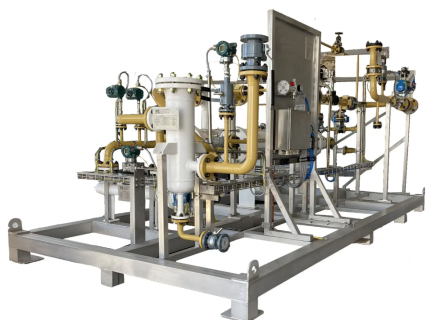H₂S REMOVAL
Removing hydrogen sulfide (H₂S) from gas streams is essential for ensuring safety, protecting equipment, and meeting environmental regulations. Our H₂S removal systems are designed to effectively capture and eliminate this toxic and corrosive gas from natural gas, biogas, and other industrial streams. By employing advanced chemical and physical absorption technologies, we ensure that H₂S levels are reduced to meet industry standards, preventing corrosion, reducing environmental impact, and improving the overall quality of your gas. With a focus on efficiency and reliability, our H₂S removal solutions help you maintain safe operations, protect your assets, and comply with regulatory requirements.

Technical Specifications
Performance Metrics
Removal Efficiency: Achieves up to 99.9% efficiency in removing hydrogen sulphide (H₂S) from gas streams, ensuring compliance with environmental regulations and safety standards.
Flow Rates: Capable of processing gas flow rates from 10 to 100,000 standard cubic feet per minute (SCFM), making it suitable for various scales of operation from small facilities to large industrial plants.
Operating Pressure: Functions effectively under a wide range of pressures, typically from 10 to 150 bar, allowing for seamless integration with existing gas processing infrastructure.
Sulphur Recovery: Offers high sulphur recovery rates, converting H₂S into elemental sulphur or sulphuric acid, which can be repurposed for industrial use or safely disposed of.
Materials Used
Absorption Towers: Constructed from corrosion-resistant alloys such as stainless steel or Hastelloy to withstand the acidic environment during H₂S removal.
Chemical Solvents: Utilises advanced chemical solvents like amines or proprietary blends that efficiently capture and remove H₂S from gas streams.
Catalysts and Reactors: Equipped with high-performance catalysts and reactors designed to facilitate the conversion of H₂S into elemental sulphur or other safe compounds.
High-Grade Seals and Gaskets: Features durable seals and gaskets made from materials like Viton or PTFE, ensuring leak-free operation under harsh conditions.
Applicable Environments
Natural Gas Processing Plants: Ideal for natural gas processing facilities, where the removal of H₂S is essential to protect equipment, meet pipeline specifications, and ensure worker safety.
Refineries: Suitable for use in oil refineries, where H₂S removal is critical for protecting catalysts, improving product quality, and reducing emissions.
LNG and LPG Facilities: Applicable in LNG (Liquefied Natural Gas) and LPG (Liquefied Petroleum Gas) production facilities, ensuring the removal of H₂S to prevent corrosion and contamination in storage and transportation.
Offshore and Onshore Gas Fields: Designed for use in both offshore and onshore gas fields, providing reliable H₂S removal solutions in remote and challenging environments.